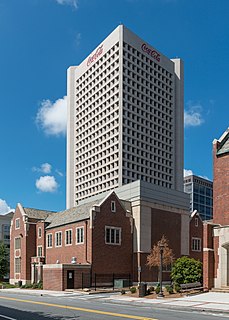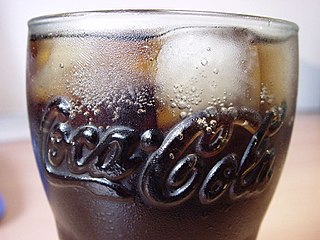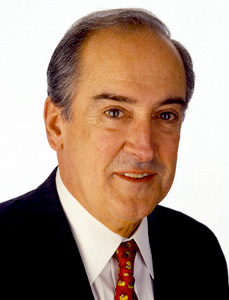Coca Cola Corporation was an Atlanta, Georgia company, the first large-scale manufacturer and marketer of beverages based on the Coca-Cola formula, and closely related to The Coca-Cola Company, the corporation that took on that role by 1900 and became a worldwide business.

Coca-Cola, or Coke, is a carbonated soft drink manufactured by The Coca-Cola Company. Originally intended as a patent medicine, it was invented in the late 19th century by John Stith Pemberton and was bought out by businessman Asa Griggs Candler, whose marketing tactics led Coca-Cola to its dominance of the world soft-drink market throughout the 20th century. The drink's name refers to two of its original ingredients: coca leaves, and kola nuts. The current formula of Coca-Cola remains a trade secret, although a variety of reported recipes and experimental recreations have been published.

The Coca-Cola Company is an American corporation, and manufacturer, retailer, and marketer of nonalcoholic beverage concentrates and syrups. The company is best known for its flagship product Coca-Cola, invented in 1886 by pharmacist John Stith Pemberton in Atlanta, Georgia. The Coca-Cola formula and brand were fully bought with US$2,300 in 1889 by Asa Griggs Candler, who incorporated The Coca-Cola Company in Atlanta in 1892.
After Asa Candler purchased the formula in 1899 from its developer, druggist John Pemberton, the latter's alcoholic son Charley Pemberton returned from Louisville, Kentucky the next year. He claimed his father had promised him the rights to the formula. The father corroborated this, and the incorporation proceeded with the younger Pemberton joining Candler and Woolfolk Walker as the principals.

Louisville is the largest city in the Commonwealth of Kentucky and the 29th most-populous city in the United States. It is one of two cities in Kentucky designated as first-class, the other being Lexington, the state's second-largest city. Louisville is the historical seat and, since 2003, the nominal seat of Jefferson County, located in the state's north and on the border with Indiana.
With Candler and Walker soon at odds with Charley Pemberton, his father announced that it was the rights to the Coca-Cola name but not the formula that he had conveyed to the son. Though he remained a shareholder in Coca Cola Corporation, the son left the company in the summer of 1888, and began selling a lower-quality version of the beverage, under the name Coca-Cola. Fearing this would erode the value of that name, the corporation renamed its product as Yum Yum and then as Koke, with poor success.
Candler decided by 1894 to focus on the name and formula, and abandoned the troubled corporation, starting, without its other principals, a new corporation, The Coca-Cola Company. In the same year, Charley Pemberton died at the age of forty, after an apparent overdose of opium, as he was probably addicted to it like his father.

Opium is the dried latex obtained from the opium poppy. Approximately 12 percent of the opium latex is made up of the analgesic alkaloid morphine, which is processed chemically to produce heroin and other synthetic opioids for medicinal use and for illegal drug trade. The latex also contains the closely related opiates codeine and thebaine, and non-analgesic alkaloids such as papaverine and noscapine. The traditional, labor-intensive method of obtaining the latex is to scratch ("score") the immature seed pods (fruits) by hand; the latex leaks out and dries to a sticky yellowish residue that is later scraped off and dehydrated. The word "meconium" historically referred to related, weaker preparations made from other parts of the opium poppy or different species of poppies.
The Coca-Cola Company remained vulnerable, until the inactive Coca Cola Corporation's charter expired in 1908, to legal challenges from it.










